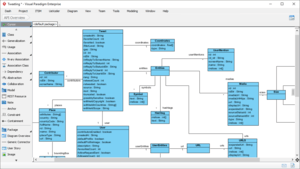Visual Paradigm
|
| |
 Visual Paradigm 15.0 running on Windows 10 | |
| Developer(s) | Visual Paradigm International Ltd.[1] |
|---|---|
| Initial release | 20 June 2002 |
| Stable release |
15.0
/ February 27, 2018 [2] |
| Operating system | Cross-platform |
| Type | UML Tool |
| License | Proprietary with Free Community Edition |
| Website |
www |
Visual Paradigm (VP-UML) is a UML CASE Tool supporting UML 2, SysML and Business Process Modeling Notation (BPMN) from the Object Management Group (OMG). In addition to modeling support, it provides report generation and code engineering capabilities including code generation. It can reverse engineer diagrams from code, and provide round-trip engineering for various programming languages.
Product Editions
Higher-priced editions provide more features.[3]
The following editions were available in November 2010:
- Community Edition
- A free edition for non-commercial use. Supports all 13 UML diagram types.
- For non-commercial use only.
- Modeler Edition
- Standard Edition
- Professional Edition
- Enterprise Edition
- Supports BPMN 2.0 for modeling of business processes.
UML Modeling
Visual Paradigm supports 13 types of diagrams:
Requirements Management
Visual Paradigm supports requirements management including user stories, use cases, SysML requirement diagrams and textual analysis.
A SysML requirement diagram specifies the capability or condition that must be delivered in the target system. Capability refers to the functions that the system must support. Condition means that the system should be able to run or produce the result given a specific constraint. Visual Paradigm provides a SysML requirement diagram for specifying and analyzing requirements.
Business Process Modeling
Supports BPMN 2.0 for modeling of business processes. The latest version (Aug 2016) also supports Case Management with CMMN.
Data Modeling
Visual Paradigm supports both Entity Relationship Diagrams (ERD) and Object Relational Mapping Diagrams (ORMD). ERD is used to model the relational database. ORMD is one of the tools to show the mapping between class from object-oriented world and entity in relational database world.